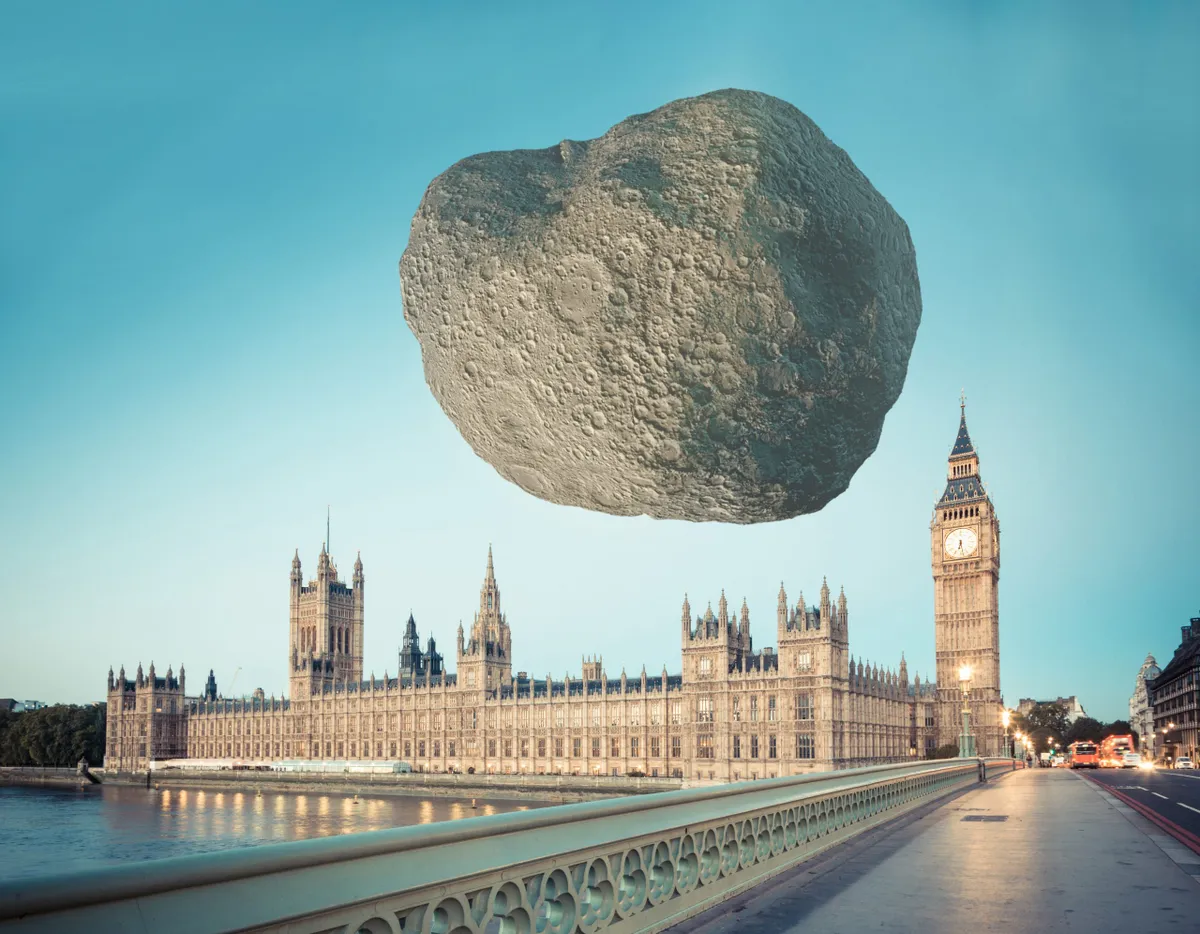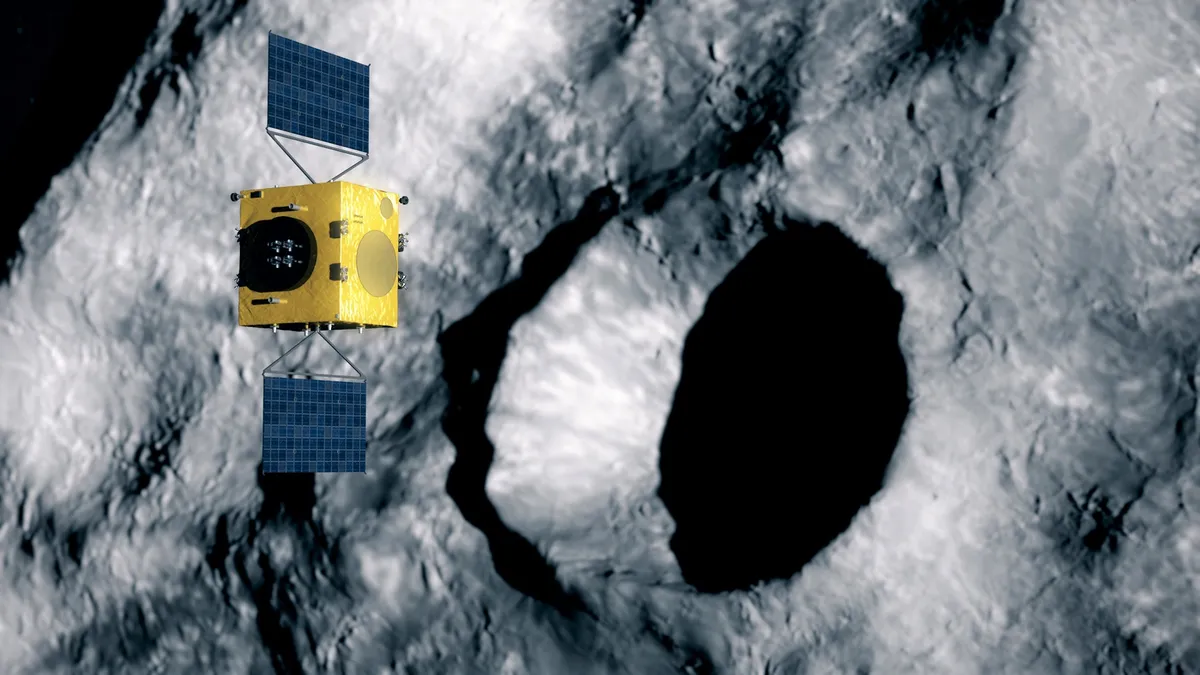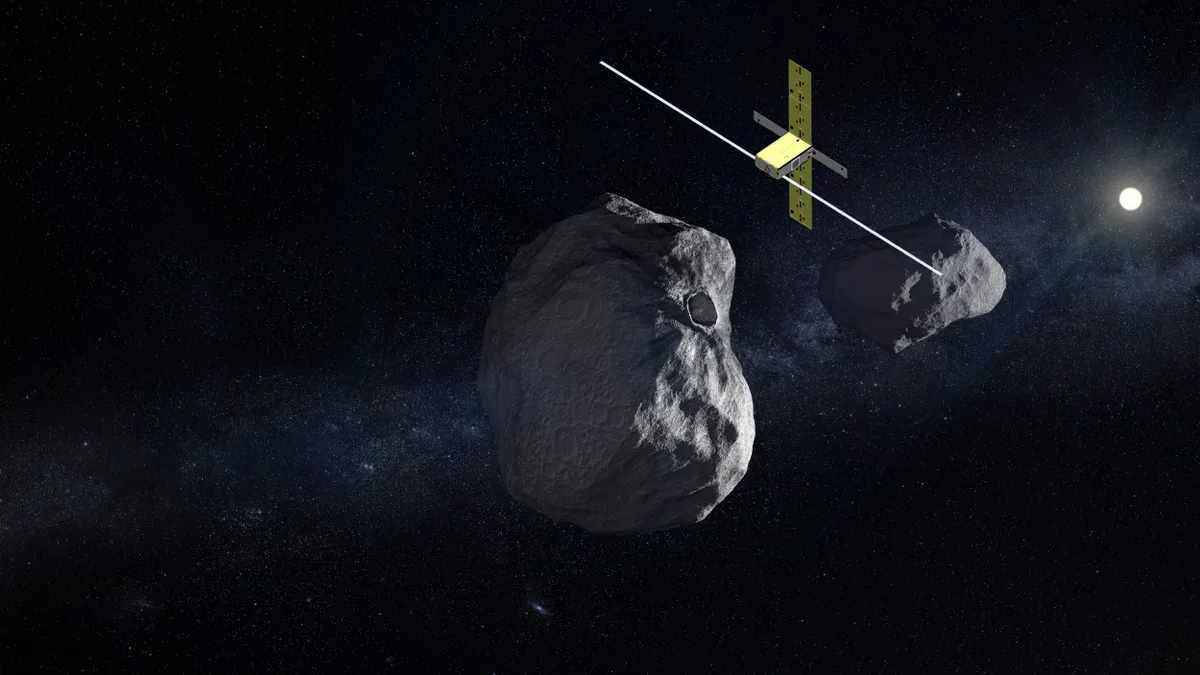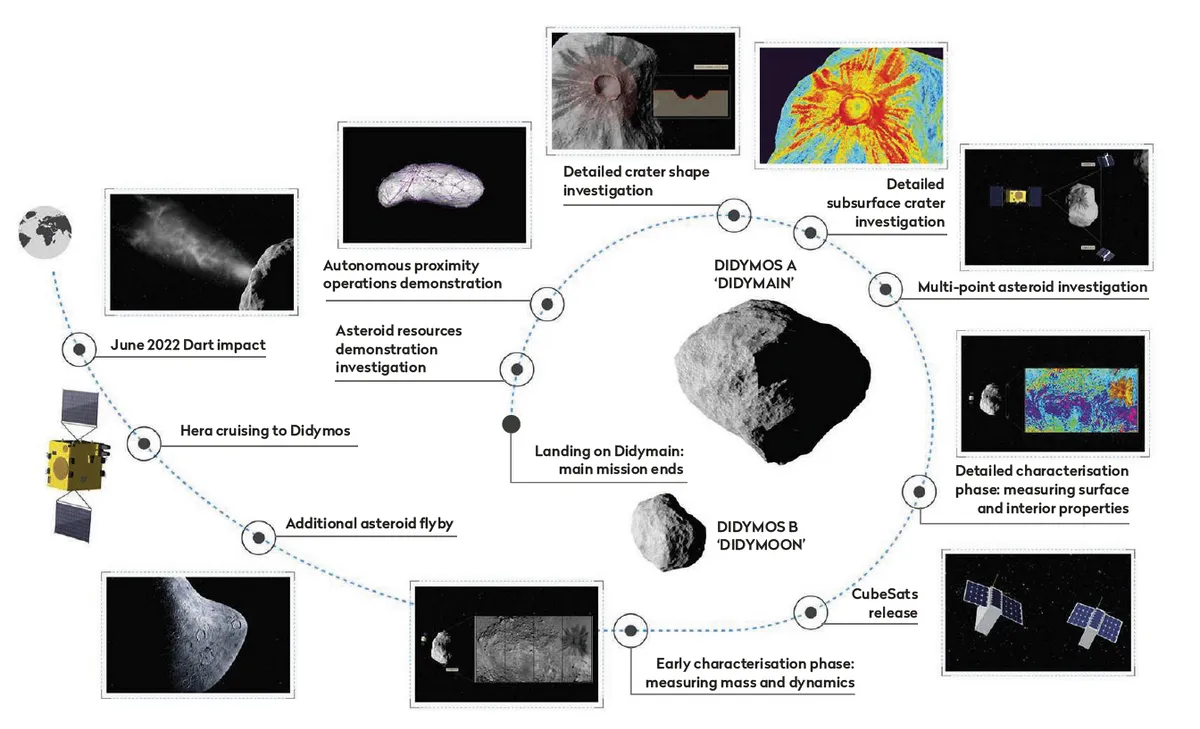Most efforts to protect against civilisation-killing asteroids have been focused on finding them rather than what to do once they're found. That will soon change with European Space Agency's Hera mission – a project to learn how to deflect an asteroid.
In 2022 Hera's sister spacecraft, DART (Double Asteroid Redirection Test) plans on journeying to near-Earth asteroid Didymos. The NASA spacecraft will slam into the asteroid's orbiting moonlet at 6.6km/s, aiming to change its orbit.
Hera will then arrive at the asteroid to fully measure how much of an 'impact' DART has made on the asteroid and its trajectory.
The target has been carefully chosen. Didymos is in solar orbit between Mars and Earth.
The orbiting moonlet, Didymos B, or 'Didymoon', is 160m across, about the size of the Great Pyramid, is in the asteroid class capable of generating casualties on a regional scale, were it to impact Earth.

It orbits around the main 780m-diameter, mountain-sized asteroid. This might sound substantial, but the main asteroid has a low enough mass and gravity that Didymoon orbits around it slowly, at less than 20cm per second – a speed which makes achieving a measurable deflection straightforward.
Didymoon’s degree of orbital deflection will be measurable from Earth by decoding radar signals and light curves gathered via our planet’s telescopes.
What is the Hera mission?
After DART’s impact, Europe will take a lead in the historic undertaking: the European Space Agency (ESA) is finalising and launching a second spacecraft to closely investigate this unique, orbitally modified body.
ESA’s Hera mission, named after the Greek goddess of marriage, is due to launch in 2024.
“The mission’s goal is to acquire crucial collision data we can’t obtain from long-distance observation,” says astronomer Patrick Michel of France’s Côte d’Azur Observatory, Hera’s lead scientist. “This includes measuring Didymoon’s mass, structure and compositional properties, as well as taking a close-up look at the crater left by DART’s impact.”

Hera was approved to fly by ESA’s Ministerial Council late last year, marking a dramatic comeback, since the mission proposal had been withdrawn at the same venue some four years earlier.
“The [withdrawl] came after years of work on the Asteroid Impact Mission (AIM), Hera’s predecessor, when the mission wasn’t able to raise sufficient financial support from ESA member states,” recalls Ian Carnelli, managing Hera for ESA. “However, some countries had expressed enthusiasm for the concept, so development work continued.”
Hera’s broad mission goals remain the same as AIM’s: firstly to be Europe’s contribution to this grand international planetary defence experiment; AIDA – the Asteroid Impact and Deflection Assessment as the joint mission is known – will see DART and Hera mutually enhance their respective results.
Secondly, Hera will gather experience of extremely low-gravity operations, which will come in handy for future asteroid resource prospecting.
Thirdly, Hera will perform as much usable science in the process: it will be Earth’s first ever expedition to the still mysterious class of binary asteroids that make up about 15 per cent of all known asteroids, and it will mount the first investigation of an asteroid interior through radar sounding.
But the redesigned Hera also lost some mission facets, including a small lander and a powerful laser to relay data back to mission control. The desk-sized mission does retain other ambitious elements, most notably a pair of CubeSats – shoebox-sized spacecraft built up from 10cm cubic units, able to fly much closer to the surface than Hera itself.

“These two will be Europe’s first CubeSats in deep space, each operating independently, with Hera as their relay mother ship,” explains Carnelli.
“The ‘Juventas’ mission CubeSat will perform the first radar survey of an asteroid’s interior, employing an antenna longer than the CubeSat itself, while a second CubeSat will perform spectral measurements of both Didymos asteroids, identifying what they are made of down to individual boulders, as well as some dust investigations.”
The CubeSats will end their missions by touching down on either Didymos A (‘Didymain’) or its moonlet – although with the asteroid’s low gravity it will be more like docking than landing.
Hera’s own main imager actually comes secondhand: the German-developed Asteroid Framing Camera was originally built for NASA’s Dawn mission to the two largest bodies in the asteroid belt, Ceres and Vesta.
“This is a flight spare, which we’ll be using both for science and for navigation,” says Carnelli.
“When we get close we’ll be performing tracking of surface features such as craters and boulders. This is both to know where we are in space with respect to the asteroid, but also for a novel method of determining Didymoon’s mass – looking for small wobbles in the main asteroid’s rotation relative to their combined centre of gravity.”
Simply measuring Didymoon’s gravitiational tug on Hera’s trajectory will represent a challenge, because the gravitational field of the main asteroid will swamp its moonlet.
An Apollo astronaut on asteroids
Apollo 9 Rusty Schweikart isone of the founders of the B612 Foundation, a sponsor of Asteroid Day, who has spent years investigating asteroid deflection techniques.

“More and more asteroids were being discovered, but nobody was talking about what to do if one comes our way. We asked if technology was at a point where it’s worth considering what to do. It turned out it was: with sufficiently advance knowledge we probably could deflect an asteroid.”
That work led in turn to the first inklings of AIDA, and what has become DART and Hera. “We stopped talking about a deflection mission and switched to a deflection campaign,” says Schweickart.
“You need an observer spacecraft as well as a deflector, to be sure the deflection has worked as planned. If it hasn’t, the observer could help fine-tune the asteroid’s modified orbit, serving as a ‘gravity tractor’ – using its own mass to tug the body in a different direction.”
Hera will also carry a compact ‘lidar’ laser altimeter to perform surface mapping, as well as a thermal infrared instrument whose temperature measurements should give an idea of the asteroid’s surface makeup. In addition, the mission will see how proximity to the asteroids affects its radio link with Earth, to gain insight into their mass and internal structure.
Less than a third the size of ESA’s Rosetta comet mission, Hera will be a smart but comparatively simple spacecraft – a vision which won over ESA member states second time around. “We couldn’t help but feel nervous after 15 years of asteroid deflection mission concepts research,” recalls Carnelli. “It was a huge relief when Hera was approved as part of ESA’s Space Safety programme, along with asteroid-detecting ‘flyeye’ telescopes, a new space debris monitoring system and Europe’s first space junk removal mission.”

Now comes the effort to make the Hera mission’s 2024 launch date, which will see it arrive at the Didymos system in 2027. “It isn’t such a long time away at all,” says Carnelli. “And we’re working around the COVID-19 pandemic as much as possible, videoconferencing with industrial partners in almost every corner of Europe.”
